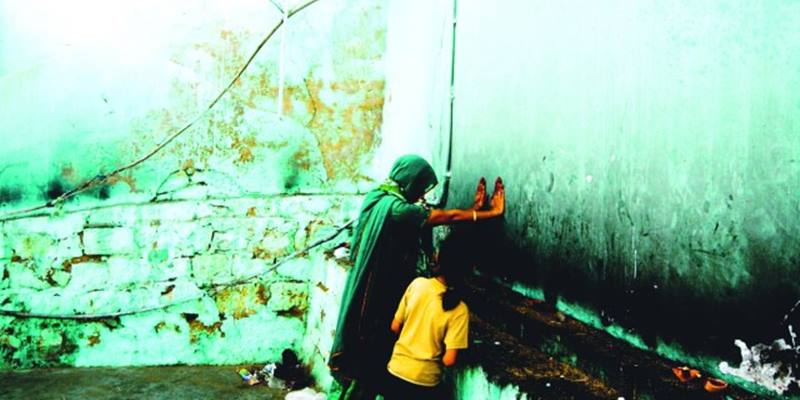Published in The Express Tribune
By Aroosa Masroor
While a good portion of the city’s residents felt compelled to move from the coastline, worried about the destruction Phet might bring, hundreds flocked to Abdullah Shah Ghazi’s shrine with their binoculars as if to challenge the cyclone.
“This place was full of people,” says the shrine’s caretaker Sardar Ahmed, pointing towards the corridor outside the shrine that overlooks Clifton beach. Much to the amusement of these visitors, the cyclone eventually fizzled out, an act most people attribute to the saint’s blessings.
“We knew the cyclone would not strike Karachi. It never has. Only those who have faith in this saint firmly believe this,” says Ahmed, who now refers to the saint as Shehenshah.
He also rubbishes the claim that a wall of the shrine broke due to the high-pressure winds and heavy rainfall on June 5, a night before the cyclone was expected to hit Karachi’s coastline. “Only a small shed fell off. The media should stop exaggerating; they need to verify what actually happened,” he adds, resentfully.
One of the sweepers, Saleem Michael, was on special duty at the shrine that day. According to a legend, the shrine of Shah Ghazi should be kept clean and well-maintained to protect the city from a deadly sea storm. “My wife did panic for a bit, but I had to be here,” says Michael. He has been working at the shrine for about 17 years and firmly believes in its power.
Caretakers at the shrine added that the number of devotees who turned up at the mazaar to pay homage to the saint increased. Sardar Ahmed observed the same thing after the two storms in 2006, which were supposedly deflected by the Sufi saint to the Indian city of Gujarat when they were just 12 hours away from Karachi’s coast. In fact no tropical disaster has hit Karachi’s coast in the past thousand years because of the shrine’s blessing. Or so innumerable Karachiites believe.
The saint and the sea
Many say that peoples’ faith in the saint is not entirely unfounded. Legend has it that Abdullah Shah Ghazi was able to control the sea waters using a bowl in the sea and ordering it to remain calm. “This was done to help the fishermen who approached him because they were unable to earn their livelihood in the rough sea,” narrates Ahmed.
The saint is believed to have pressed the bowl from both sides in the sea while narrating a prayer, asking for the waters to remain calm. A few hours later, the fishermen were back at work.
It was perhaps due to this belief that most fishermen in Sindh chose to ignore the warnings issued by the Pakistan Meteorological Department and the Tropical Cyclone Warning Centre, while residents along Sea View evacuated their homes.
“A lot of people rubbish these myths, but if one traces the history of this shrine they will realise that there is some truth to it,” says a devotee, who prefers to be known as Allahrakha. It was evident from his long hair and unkempt beard that Allahrakha was a malang but he had yet another interesting fact to share. “Have you ever wondered why the water of the entire Arabian Sea is brackish, but what trickles behind the shrine is sweet? This is the miraculous holy water that cures ailments of people who visit the shrine.”
The history of shah ghazi
Born in the year 720 in one of the holiest cities in Islam, Madina, Abdullah Shah Ghazi was the great grandson of the Holy Prophet (pbuh) from the historical tribe of Bani Hashim. He was educated in Madina until the year 760 when he migrated to Sindh as a merchant. He was given a warm welcome as he belonged to the Saadat family, one of the noblest in Islam.
Another version of Shah Ghazi’s life has been given by the internationally acclaimed scholar and historian, Dr Umar Bin Mohammad Daudpota . According to him, Abdullah Shah’s real name was General Abdulla bin Nabhan. He, along with Badil bin Tuhafa, another commander, launched a military expedition against Raja Dahir, the local ruler who was encouraging pirates to raid Arab ships. Consequently, war ensued at Debil, modern day Karachi.
Later, the mission was entrusted to Muhammad Bin Qasim. While the young commander forged ahead to Multan, Abdullah Shah continued to live in Sindh with the people he loved, teaching them the principles of Islam and spreading his love for humanity. Back then Sindh had plenty of wildlife – ibex, urial, blue bull, gazelle and deer – and Abdullah Shah was fond of hunting. One day, in his passion for hunting, Abdullah Shah wandered far from the base and was intercepted by the enemy. Out-numbered, he preferred to fight rather than surrender. Because of this display of valor, he was given the title of Ghazi (Victorious).
He died in 773 and was buried near the sea in Karachi. His tomb is built on a very high platform, but the actual grave is below the stairs. His mazaar attracts a steady stream of devotees for a number of reasons: for preaching love and tolerance, and warding off tropical disasters. As recent events show, it seems to work.
Published in the Express Tribune, June 20th, 2010.



